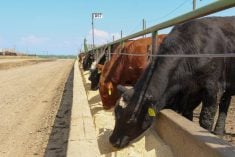I’ve received many inquiries over the past couple of months regarding the potential effects of U.S. corporate and personal tax cuts on beef demand. I know most producers focus on cattle inventory numbers and cattle-on-feed reports, but old-time cattle producers often remind me that focusing on demand is the secret to long-term success in the cattle business.
I’ve mentioned in previous articles that a one per cent increase in consumer spending results in a one per cent increase in beef demand. Under the new tax structure, which is expected to take effect in late February, a family of four making a combined income around $75,000 will take home additional $2,244 per year. A family making $175,000 will have a tax saving of $3,095. This is fairly significant and that’s why this bill is such a historical landmark.
Read Also

Harvest wraps up and fall work begins
At the Eppich famly ranch in western Saskatchewan, the fall harvest was successful with few breakdowns, cows and calves have been sorted and a new tractor has arrived
The U.S. and Canadian economies have been in the later part of the expansionary phase of the business cycle for some time. (For those producers who are a bit rusty on their economic terms, the business cycle has four main phases: contraction, trough, expansion and peak).
Strong consumer confidence
Consumer confidence is near historical highs and unemployment levels are near historical lows. The economic environment over the next two years will include rising interest rates, stronger inflationary pressures and lower taxes. So how does the cattle market behave when consumer incomes increase and what are the potential effects of the “Trump tax cuts” on overall beef demand?
I’ll start with a history lesson to clearly explain how the cattle market behaves when consumer incomes increase. The Monthly Live Cattle Futures chart shows two examples of expansionary phases of the U.S. economy. Each example shows the absolute low of the trough phase and the optimal point of the peak phase when the economy was running at full capacity. The first case is from November 1970 to November of 1973 when prices moved from $28 to $54. Prices nearly doubled in this three-year period.
The next major economic expansion was from March of 1975 to Jan of 1980. Prices moved from a low of $41 to a high of $77. This reflects an 87 per cent increase in price from low to the high. In 1974 prior to the recession, interest rates were at 10 to 12 per cent and by 1976, interest rates dropped to about five per cent during the trough phase. We all know how interest rates reached record highs of 20 per cent in the early 80s, to stall out the economy and slow consumer spending.
I haven’t shown our last recession, which should still be fresh in everyone’s mind. The absolute price low of the recession was in the first half of 2009 when the futures dipped to $81. The futures market made all-time highs near $172 in October of 2014. The market has faded since the 2014 highs, but economy has another gear with the forthcoming tax changes.
Very simply, in the long run, lowering taxes is the most beneficial for all income levels. The closer the economy is to a free market so that an individual can keep more of what he earns, the higher the income for all citizens.
The U.S. corporate tax rate stands at 35 per cent but will be lowered to 21 per cent. Secondly, there is currently more than US$2 trillion in profits belonging to American firms parked in foreign subsidiaries. Some news articles have it as high as US$2.5 trillion. The new dividend tax exemption will save multinationals from paying U.S. corporate tax on foreign profits brought back to the U.S. These two factors will result in private sector growth unseen in the past century. Wages are expected to rise three to five per cent over the next eight to 12 months. In addition to families taking home a larger percentage of their earnings, wages will also rise.
Could trigger inflation
The tax cuts could be the key that turns on inflation. Consumers spending will increase on everything (in proportion) from houses to furniture to food and travel. Stronger demand for goods and services will result in higher prices. U.S. short- and medium-term lending rates will increase because there will be more demand for short- and medium-term loans. The Federal Reserve has taken a “wait and see” approach on raising their short-term lending rate but in the latter half of 2018, I believe they will be reacting to recent growth. In the latter half of 2018 and 2019, interest rates will likely jump more than expected. The prime rate at major banks will likely be three to four per cent above current levels by the end of 2019.
It all points to lower personal and corporate taxes having the effect of increasing disposable income. The lower corporate tax structure will result in higher wages. Restaurant traffic will increase and consumers will be able to buy higher-quality food products on the retail shelf. By the end of 2019, we could see higher interest rates put the brakes on consumer spending.
















